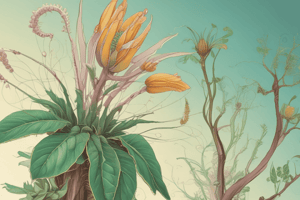Podcast
Questions and Answers
What is agamospermia?
What is agamospermia?
- A type of vegetative reproduction
- A type of sexual reproduction
- A type of seed production without fertilization (correct)
- A type of mutation in cultivated plants
What is the term used to describe seed production without fertilization?
What is the term used to describe seed production without fertilization?
- Agamospermia (correct)
- Apogametion
- Adventitious embryogenesis
- Parthenogenesis
What is the difference between parthenogenesis and apogametion?
What is the difference between parthenogenesis and apogametion?
- Parthenogenesis occurs when the seed embryo is born from the egg cells of the embryo sac, while apogametion occurs when it is born from other cells of the embryo sac (correct)
- Parthenogenesis occurs in organisms with sexual differentiation, while apogametion occurs in organisms without sexual differentiation.
- Parthenogenesis occurs in plants, while apogametion occurs in animals.
- Parthenogenesis and apogametion are the same thing.
Which type of reproduction occurs in organisms with sexual differentiation but lacks fertilization?
Which type of reproduction occurs in organisms with sexual differentiation but lacks fertilization?
What is adventitious embryogenesis?
What is adventitious embryogenesis?
What is the term used to describe the type of agamospermia where the seed embryo is born from the egg cells of the embryo sac?
What is the term used to describe the type of agamospermia where the seed embryo is born from the egg cells of the embryo sac?
Which type of reproduction involves the use of specialized organs or parts of organs for natural vegetative reproduction?
Which type of reproduction involves the use of specialized organs or parts of organs for natural vegetative reproduction?
What is the advantage of apomictic propagation and vegetative propagation?
What is the advantage of apomictic propagation and vegetative propagation?
Which type of propagation involves growing tissues or meristematic cells on a suitable nutrient medium?
Which type of propagation involves growing tissues or meristematic cells on a suitable nutrient medium?
What is the genetic control of apomixis?
What is the genetic control of apomixis?
What is the result of somatic mutations in cultivated plants?
What is the result of somatic mutations in cultivated plants?
What is the term used to describe the genetic control of the phenomenon of apomixis?
What is the term used to describe the genetic control of the phenomenon of apomixis?
What is the effect of transplantation on mutations?
What is the effect of transplantation on mutations?
Which type of reproduction leads to the accumulation of cytoplasmic accidents?
Which type of reproduction leads to the accumulation of cytoplasmic accidents?
What is the term used to describe the transmission of orthotropy and plagiotropy along vegetative multiplications in some species?
What is the term used to describe the transmission of orthotropy and plagiotropy along vegetative multiplications in some species?
What is orthotropy and plagiotropy?
What is orthotropy and plagiotropy?
Which type of propagation can lead to individuals with good phytosanitary status?
Which type of propagation can lead to individuals with good phytosanitary status?
What are cytoplasmic accidents?
What are cytoplasmic accidents?
What is in vitro culture used for in plant improvement?
What is in vitro culture used for in plant improvement?
Which type of culture has successfully combated viruses that systematically affected numerous plant varieties?
Which type of culture has successfully combated viruses that systematically affected numerous plant varieties?
Flashcards are hidden until you start studying
Study Notes
- Most cultivated plants reproduce sexually through seeds, but some species reproduce apomictically through asexual methods.
- Apomictic reproduction is characterized by the lack of fertilization and occurs in organisms with sexual differentiation.
- Agamospermia refers to seed production without fertilization.
- Parthenogenesis and apogametion are types of agamospermia where the seed embryo is born from the egg cells of the embryo sac or other cells of the embryo sac, respectively.
- Adventitious embryogenesis is characteristic of organisms where seed embryos are produced without fertilization from somatic cells.
- Vegetative reproduction is another type of apomictic reproduction, where plants use specialized organs or parts of organs for natural vegetative reproduction.
- Transplantation, including grafting, is an artificial system of vegetative multiplication used in viticulture and fruit growing.
- Meristematic propagation is an artificial apomictic propagation where tissues or meristematic cells are detached and grown on a suitable nutrient medium.
- Apomictic propagation and vegetative propagation have special advantages for plant improvement, especially in perpetuating valuable plants and maintaining certain properties and valuable characters.
- The phenomenon of apomixis is genetically controlled, and hereditary conservatism is not absolute, depending on the hereditary conservatism of the initial mother plant.
- Natural somatic mutations can occur in cultivated plants, leading to frequent bud variations.
- Somatic mutations usually occur in one layer of cells and are only partially expressed.
- Transplantation can sometimes cause mutations to be transferred to the epidermal area.
- Spontaneous mutagenesis allows for diversification and adaptation potentials in vegetatively reproducing species.
- Orthotropy and plagiotropy are transmitted along vegetative multiplications in some species.
- Vegetative multiplication can lead to the accumulation of cytoplasmic accidents.
- Cytoplasmic accidents are often due to the presence of latent viruses or mycoplasmas in cells.
- In vitro culture from meristems or embryos can lead to individuals with good phytosanitary status.
- Viruses that systematically affected numerous varieties have been successfully combated through in vitro culture.
- Accumulation of mutations in the heterozygous stage is considerable during cell divisions.
Studying That Suits You
Use AI to generate personalized quizzes and flashcards to suit your learning preferences.




